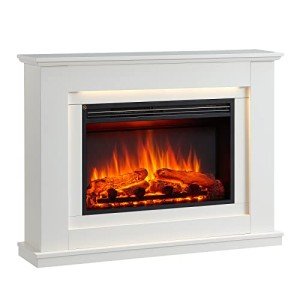10 Things Everybody Gets Wrong About The Word "Fireplace."

The Fireplace: A Warm Embrace of Tradition and Comfort
Fireplaces have actually been an essential part of human habitation for centuries, serving as a source of warmth, a meeting place, and a symbol of convenience. While the modern variations may vary extremely from their ancient forefathers, the allure of a fireplace sustains. This post checks out the numerous elements of fireplaces, including their history, function, types, and upkeep, while likewise resolving regularly asked concerns.
The Evolution of Fireplaces
Fireplaces go back to prehistoric times when open flames were used for cooking, heating, and defense from wildlife. Over Fireplaces Sale , fireplaces developed from easy fire pits to the sophisticated performances we see today. Here is a quick timeline of their evolution:
- Prehistoric Era: Cavemen utilized open flames for warmth and cooking. Wind and smoke often blew into dwellings.
- Middle Ages: Stone and brick fireplaces became common in homes and castles, incorporating chimneys to carry smoke outside.
- Renaissance: Elaborately developed mantels emerged, and fireplaces became centers of social interaction.
- Industrial Revolution: Innovations in heating materials caused a range of styles and performances.
- Modern Era: The development of gas, electric, and bioethanol fireplaces provided cleaner alternatives to traditional wood-burning systems.
Table 1: The Evolution of Fireplaces
| Age | Characteristics |
|---|---|
| Ancient Era | Open flames for heat and cooking |
| Middle Ages | Stone and brick structures with early chimneys |
| Renaissance | Elaborate mantels, social centers |
| Industrial Revolution | Varied styles, development of brand-new materials |
| Modern Era | Gas, electric, and bioethanol choices |
The Purpose of a Fireplace
Fireplaces serve dual functions: they supply physical warmth and create an emotional environment. Homeowners frequently gather around the fireplace to bond, share stories, and take pleasure in a cozy setting. The glow of a fire can be calming, adding to a sense of relaxation and intimacy. Beyond individual satisfaction, fireplaces likewise offer practical benefits, including:
- Home Heating: Effective heat source, particularly in cooler environments.
- Increased Home Value: A well-designed fireplace can boost the aesthetic worth of a home.
- Emergency Heating: In case of power blackouts, wood-burning fireplaces can work as an important heat source.
- Aesthetic Appeal: A focal point that contributes to interior design.
Kinds of Fireplaces
Today, fireplaces can be found in different styles and fuel types, accommodating a varied range of choices and settings. Here are some common types:
Wood-Burning Fireplaces:
- Traditional fire pits
- Timeless masonry fireplaces
- Need significant upkeep and chimney upkeep
Gas Fireplaces:
- Available in both direct vent and ventless varieties
- Much easier to use and keep than wood-burning fireplaces
- Supply instantaneous heat with a flick of a switch
Electric Fireplaces:
- Offer associated heat sources without genuine flames
- Typically designed to imitate traditional fireplaces
- Ideal for smaller areas and homes without a chimney
Bioethanol Fireplaces:
- Use bioethanol fuel, offering a sustainable alternative
- Require no ventilation and can be put anywhere
- Safe and easy to preserve
Table 2: Types of Fireplaces
| Type | Fuel Source | Functions | Upkeep Requirements |
|---|---|---|---|
| Wood-Burning | Wood | High ambiance, heat source | Regular chimney cleansing |
| Gas | Natural gas or propane | Instantaneous heat | Minimal, occasional maintenance |
| Electric | Electrical energy | Easy setup | Extremely low upkeep |
| Bioethanol | Bioethanol fuel | Ventless, portable | Low, primarily cleaning up |
Maintenance and Safety Considerations
Owning a fireplace includes specific responsibilities, specifically concerning its safe operation and long-term maintenance. Here are necessary maintenance pointers and safety guidelines:
Maintenance Tips:
- Annual Inspection: Always have your chimney and fireplace examined at least as soon as a year by a qualified professional.
- Routine Cleaning: Clean out ashes and particles after each usage, and make sure the flue is open before beginning a fire.
- Look for Cracks: Inspect masonry for cracks or damage to prevent structural problems.
- Usage Proper Fuel: Only usage dry, skilled wood for wood-burning fireplaces; do not burn cured wood.
Security Guidelines:
- Install Smoke Detectors: Ensure smoke detectors are functional, testing them monthly and changing batteries as required.
- Keep a Fire Extinguisher: Have one close-by, even if a fireplace is utilized infrequently.
- Monitor Flames: Never leave a fire ignored, and ensure children and animals are kept track of around the fireplace.
Regularly Asked Questions (FAQs)
1. How can I minimize smoke from a wood-burning fireplace?
To minimize smoke, usage dry, seasoned wood, and make sure that your chimney is clean and unblocked.
2. Is it safe to utilize gas fireplaces throughout a gas leakage?
Never ever utilize a gas fireplace throughout a gas leakage. Right away evacuate the area and contact gas services for assistance.
3. Can I install an electric fireplace myself?
Electric fireplaces are typically simple to install, however it is recommended to seek advice from experts to make sure safety and compliance with regional building regulations.
4. What is the best type of fireplace for small areas?
Electric fireplaces or bioethanol models are typically best for small areas, as they do not require extensive ventilation or structural modifications.
Fireplaces have transcended their initial purpose of offering heat to become cherished components of home design and family life. They evoke memories of warmth, celebrations, and togetherness while offering functional benefits that enhance modern living. By understanding the various kinds of fireplaces, their upkeep, and security practices, property owners can delight in the timeless appeal of this cherished feature for generations to come.

